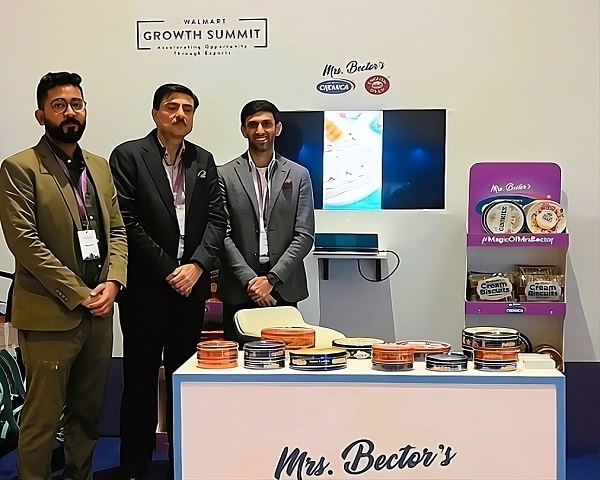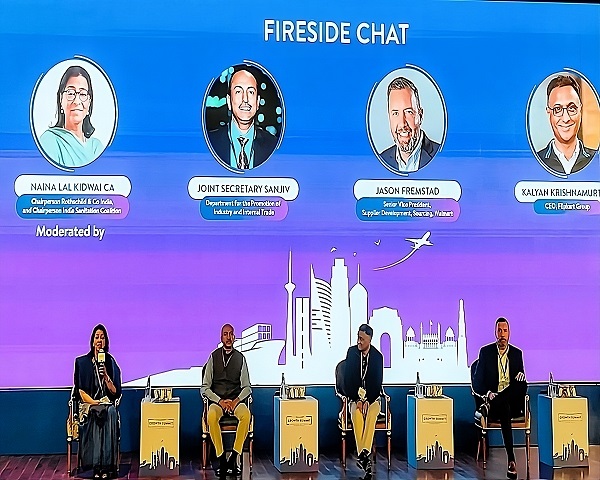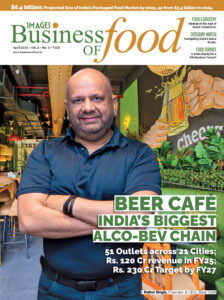India’s manufacturing capacity is broadening and scaling day by day, bolstered by a growing business ecosystem and a strong infrastructure. Today the nation stands on the global stage of business and innovation, trying to achieve the goal of a trillion-dollar economy in a compressed timeline. Walmart, a global retail leader rooted in the US, recognizes this growing potential of the nation and trying to establish a stronger foothold in the Indian market.
To spread its wings in the Indian domain and to create a link between Indian manufacturers and the demands of Indian goods all across the globe, the brand has organized a Growth Summit. This summit serves as a collaborative platform bringing together MSMEs, manufacturers, and small retailers, to catalyze exports from India.
Walmart’s vision is to facilitate the sourcing of $10 billion worth of goods annually by 2027, thereby fostering economic growth and international trade partnerships with India.
The entrepreneurial spirit runs deep in the veins of every Indian. Every Indian dreams of owning their own business. The Make-in-India initiative acts as a beacon, amplifying the already existing passion for embarking on this entrepreneurial journey that resides in the heart of every Indian.
Walmart, a global retail leader rooted in the US, recognizes this passion of Indian manufacturers and graduates, paving a pathway for them to become integral parts of the retail journey through their Growth Summit held in New Delhi.
The retailer which has been invested in India for over 2 decades, has brought together its Indian partners, Flipkart and PhonePe, suppliers, and supply chain innovators to share the commitment to boost India’s economy and become a leading supplier of Indian goods on the global stage.
Walmart’s mission is to accelerate its exports in India across different product categories such as food, consumables, health and wellness, general merchandise, apparel, shoes, home textiles, and toys, sourcing $10 billion of goods each year by 2027.
‘‘We’ve made investments in Flipkart, PhonePe, Myntra, and Ninja Cart. We’re committed to helping India’s economy grow, which is on track to hit $ 4 trillion’’, says Kathryn McLay, President and CEO, Walmart International.
While the target may appear zealous, Walmart’s faith in India’s potential, coupled with the initiatives undertaken by the Government of India to streamline Foreign Direct Investment (FDI) and boost trade, can transform this distant dream into reality.
Elevating people and communities
As described by CEO Doug McMillon, Walmart is a people-led, tech-powered Omni channel retailer dedicated to helping people save money and live better. The brand is committed to its 2.1 million associates that make the difference.
‘‘As a company, our mission encompasses fostering a positive and a healthy culture, offering career advancement opportunities to enable everyone to realize their full potential, and ensuring that every individual feels a sense of belonging within our organization. We provide a pathway to success, facilitating growth and development for all. While our commitment to people remains paramount, technology plays a pivotal role in our operations. We have evolved into a true omnichannel retailer, seamlessly integrating our human capital with technology to cater to the diverse needs and preferences of our customers.’’ says McMillon.
As part of its business philosophy, Walmart has extended its reach into the Indian market to source distinctive, artisanal, and high-quality Indian goods at affordable prices for its customer base. To enhance its supply chain logistics in India, the company has introduced innovative initiatives aimed at bolstering Indian manufacturing industries and MSMEs to meet its demands.
Walmart is committed to offering essential items to its customers at affordable prices, striving to make a positive difference in people’s lives by helping them save money and improve their quality of life. ‘‘Our strategy is simple. It’s to help people save money and enhance their quality of life. We want to give them value for their money, we save their time and we do our part to strengthen their communities and planet, ’’ says Doug.
Empowering MSMEs in India
In order to strengthen the MSMEs in India, and to spread its wing in the Indian domain, Walmart is creating a link between the Indian manufacturers and the demands of Indian goods all across the globe. The Walmart Foundation has introduced a supplier development program, ‘Walmart Vriddhi’ in India to empower more than 50,000 MSMEs over five years.
Launched in December 2019, the program provides free training, mentoring, and digital tools to help businesses grow, scale, and integrate into domestic supply chains. The Walmart program, together with program partner, Swasti, offers local suppliers the chance to access training and gain business advice while tapping into Flipkart’s platform expertise.
The digital training provided to MSMEs covers many aspects of business management such as finance, marketing, workforce management, and environmental sustainability. This empowers entrepreneurs to establish their business models and contribute to employment opportunities at local level.
‘‘With the help of this program, graduates or newly budding entrepreneurs can have access to become sellers at our marketplaces. Some graduates might even have the opportunity to go on and become part of our export-ready program. Our focus is to recruit and train new suppliers to fulfill our purchase orders around the world. These orders often lead to the creation of new jobs. It also allows our suppliers to invest back in their local communities. We’ve seen this with partners like Shahi Exports. They continue to invest in manufacturing capabilities and community programs that empower women in their workforce,’’ says Andrea Albright, Executive Vice President of sourcing, at Walmart
Through this program, small and medium-sized business enterprises found opportunities to reach more customers. Moreover, the mentors who volunteer their time in this program help the MSMEs to achieve their goals. They are some of the brightest minds in India. ‘‘When we mix the expertise of our mentors with the passion of these MSMEs, the sky is the limit. It’s all about driving growth and tapping into the wonderful entrepreneurial spirit of Indian business, ’’ claims Kathryn. Doug further gave an example of an entrepreneur named Sundar whose business grew by 212% selling spices across India.
Apart from this program, Walmart also offers a variety of career paths from corporate to technology and so many more. At the end of the day, what makes the ecosystem whole is its customers. ‘‘Customers are at the center of everything that we do. Each step helps us to deliver on our company purpose to help save people money so they can live a better life. I’m so proud of the work that our teams are doing to support strong local businesses, companies, and communities. Our future is bright and I can’t wait to see what comes out of this. When companies like yours are successful, India grows,’’ says Albright.
All these measures have strengthened India’s ties with Walmart and have provided huge opportunities to the MSMEs, small retailers, and Kirana owners to not only upskill themselves but also to take their products to the global stage, expanding their business and boosting the economic progress of the country. The Growth Summit has been the driving vehicle for many local manufacturers and retailers who aspire to join Walmart and expand their business. The summit included some of the top leaders of the retail and e-commerce platform who provided a deep insight into various factors that surged the economic growth of India, fulfilling its ambition to turn into a trillion-dollar economy.
Fueling India’s Economic Growth
India’s manufacturing capacity is broadening and scaling day by day. The business ecosystem and infrastructure are significant parts of it. Today the nation stands on the global stage of business and innovation. India is trying to achieve the goal of a trillion-dollar economy in a compressed timeline.
But how will India be able to achieve this massive goal in such a short period? The answer is not that complicated. India is driving a public-private partnership bridged together by the digital infrastructure that can create immense societal impact. ‘‘There are 2 important aspects of commerce in India’’, says Kalyan Krishnamurthy, Group CEO, of Flipkart. ‘‘One is access and another is affordability. Access again can be broken down into digital access and physical access.’’
Digital access is expanding across the length and breadth of the country. Different types of users speak different languages with different income segments and live in all kinds of places where there are different types of networks. How do you make sure that they get a good experience while opening an e-commerce site? That is digital access. Physical access is how we make sure we get the product to the doorstep of the consumers wherever they live.
There are multiple aspects to that. One is of course cost, another is reach and the third is the right type of service level.
COST: One of the biggest challenges for access alone is to solve the cost structure. India in general is a low-ticket price market. Now for e-commerce or even for physical stores to deliver across the country with that kind of a cost structure and with that kind of logistics complexity is one of the greatest challenges that can enable e-commerce in the future if we can provide a solution to this challenge. So if the e-commerce and physical platform can lower their cost structure, then it will further increase its penetration. So the cost of doing business is directly related to logistics.
REACH: About two or three decades back, consumers did not have choices in Tier 2, or Tier 3 cities. If they even wanted to buy a simple branded product, they would take a train or a bus, go to the nearest big city, and look for a shopping mall. Today, they have access to millions of products from SMEs, and the entire consumerism is enabled by SMEs in India and they will continue to do that. They are the backbone of this consumerism that is going on and will continue to be in the coming years. ‘‘We have more than 500 million users on our platform Flipkart today. We have 1.4 million SMEs listed on the platform, and 250 million products today. The product listing is how much we offer today in Tier 2, Tier 3 cities,’’ affirms Kalyan.
SERVICE LEVEL: Today’s India is not just promoting the manufacturing of products, but manufacturing and selling of quality products. The government is trying to create an ecosystem where there are good startups and quality manufacturing processes. ‘‘We want to create incubators in India in line with the vision of having quality manufacturing processes and products. If we have good incubators, we will have good startups. If we have good startups, then we will have good manufacturing processes. If we have good manufacturing processes, then the quality of products will be good and cost-effective,’’ says Joint Secretary Sanjiv at the Department for the Promotion of Industry and Internal Trade, Government of India.
Diving into Digital Penetration
Apart from accessibility, innovation using technology is the only way India can reach a trillion-dollar economy. India has better mobile and digital penetration than most of the world. Even a Rikshawala or a street vendor is using digital means in India. Digital infrastructure is the way towards prosperity. Aadhar as the digital identity for every Indian, to UPI- the United Payments Interface, is a shining example of how we can bring policymakers, regulators, and private parties together to create a phenomenal impact.
‘‘India is doing more than 10 billion digital transactions on a monthly basis. Digitization through payments is a path toward the formalization of the economy. Before UPI, the broader economy in India was considered to be informal. There was earlier large number of small businesses, micro-businesses, which were not regarded as part of the formal economy, but with the launch of UPI payments, and with the digitization of transactions, a large number of businesses, millions in-fact are being brought into the formal economy at a very rapid pace,’’ says Rahul Chari, Founder and CTO of PhonePe.
What does this mean for the economy? Through digital payments, a cash flow record is created and these records are being recognized by banks opening up credits and flow-based lending, which helps these businesses to expand their footprint, increase their production, and get noticed not just by retailers but by the largest retailer across the world like Walmart. Thus, digitization is formalizing the economy which is creating a tsunami effect of positive disruption.
With the newfound confidence, MSMEs can grow their businesses and invest in technologies that are bringing these small and medium sellers to the world stage. But digital penetration is not the only force that is aiding these MSMEs, the government of India plays a crucial role in the expansion and growth of the MSMEs. Simplification of tax, better incentives schemes, and evolving or amending policies as per the new India’s requirement are very crucial aspects for trailblazing MSMEs in India.
Role of the Govt
The role of the Government of India, as the honorable PM always says, is not to do business but to be an enabler, quotes JS Sanjiv. ‘‘This is the new India, and the government wants to be accessible to everyone. Whether it is a big global retailer or a small MSME retailer from a Tier 2 Tier 3 city, the govt is responsive to their needs.’’
The govt is adapting to the soup-to-nuts approach to promote the manufacturers in India. ‘‘The whole emphasis is that whenever industry comes with an issue, government is open. We are doing extensive stakeholder consultations and considering the perspectives of all individuals. We are trying to change the law as it evolves, and tweak polices according to the demands of new India,’’ asserts Sanjiv.
Govt is opening up platforms like ONDC to expand e-commerce trade to not just towns and cities but at the grassroots level to the villages and districts to turn the vision of digital India into reality. Apart from that, the govt has tweaked many policies and simplified the taxation process to promote ease of doing business in India. We have removed almost 1500 archaic rules and tweaked few export and import rules to enhance trade in India,’’ says Sanjiv. Additionally, the government has come up with PLI schemes to promote trade in India.
Citing one such example, Sanjiv said, ‘‘Previously, there was no provision for importing products required for research-based projects. However, recognizing the importance of fostering manufacturing and innovation, the Indian government has implemented policies to facilitate the importation of such items.’’He further adds, ‘‘We aim to adapt and amend our laws or policies as it develops, ensuring that it remains relevant and responsive to evolving needs and circumstances.’’
Walmart’s Triumph with MSME Partnerships

Walmart is acquainted with export-ready suppliers, innovators, and entrepreneurs representing 24 states and union territories in the Growth Summit where these manufacturers and startups participated in pitch meetings featuring products made, grown, or assembled in India.
Various new startup brands exhibited their products under the guidance of Walmart experts showcasing their triumphs and growth aided by Walmart. Some of these brands are:
Welspun, a textile company in India, which started its journey by selling their towels in Sam’s Club. They are today known for their quality and great pricing thus fulfilling the demand of Walmart’s customer base in terms of quality and affordability.
The new cruiser-style bicycles by the brand Concord under Hero Ecotech are a special and popular item in Walmart. Ambassador Taranjit Singh Sandhu once checked out these bikes in one of their stores, claims Dough.
Mrs Bector’s Foods, an Indian supplier of cookies is another example. They made delicious Danish butter cookies which are very popular in the holiday season overseas.
All these examples clearly show Walmart’s commitment to the Indian market. The company has now cumulatively sourced more than $30 billion in products across a range of categories. Walmart Vriddhi training and mentorship program has empowered over 50,000 MSMEs and Walmart is very optimistic about its future ties with India, thus envisioning a $10 billion export goal with India.




